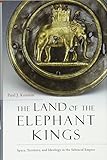The Land of the Elephant Kings : Space, Territory, and Ideology in the Seleucid Empire / Paul J. Kosmin.
Material type: TextPublisher: Cambridge, MA : Harvard University Press, [2014]Copyright date: ©2014Description: 1 online resource (439 p.) : 15 halftones, 4 maps, 5 tablesContent type:
TextPublisher: Cambridge, MA : Harvard University Press, [2014]Copyright date: ©2014Description: 1 online resource (439 p.) : 15 halftones, 4 maps, 5 tablesContent type: - 9780674728820
- 9780674416161
- 935/.062
- online - DeGruyter
- Issued also in print.
| Item type | Current library | Call number | URL | Status | Notes | Barcode | |
|---|---|---|---|---|---|---|---|
 eBook
eBook
|
Biblioteca "Angelicum" Pont. Univ. S.Tommaso d'Aquino Nuvola online | online - DeGruyter (Browse shelf(Opens below)) | Online access | Not for loan (Accesso limitato) | Accesso per gli utenti autorizzati / Access for authorized users | (dgr)9780674416161 |
Browsing Biblioteca "Angelicum" Pont. Univ. S.Tommaso d'Aquino shelves, Shelving location: Nuvola online Close shelf browser (Hides shelf browser)

|

|

|

|

|

|

|
||
| online - DeGruyter Josephine Baker and the Rainbow Tribe / | online - DeGruyter Latino Pentecostals in America : Faith and Politics in Action / | online - DeGruyter The Intellectual Life of Edmund Burke : From the Sublime and Beautiful to American Independence / | online - DeGruyter The Land of the Elephant Kings : Space, Territory, and Ideology in the Seleucid Empire / | online - DeGruyter The Medicean Succession : Monarchy and Sacral Politics in Duke Cosimo dei Medici’s Florence / | online - DeGruyter The Place of Prejudice : A Case for Reasoning within the World / | online - DeGruyter The Siege of Strasbourg / |
Frontmatter -- Contents -- Maps -- Illustrations -- Abbreviations -- Introduction -- PART I. Border -- CHAPTER 1. India - Diplomacy and Ethnography at the Mauryan Frontier -- CHAPTER 2. Central Asia - Nomads, Ocean, and the Desire for Line -- PART II. Homeland -- CHAPTER 3. Macedonia - From Center to Periphery -- CHAPTER 4. Syria - Diasporic Imperialism -- INTERLUDE -- PART III. Movement -- CHAPTER 5. Arrivals and Departures -- CHAPTER 6. The Circulatory System -- PART IV. Colony -- CHAPTER 7. King Makes City -- CHAPTER 8. City Makes King -- Conclusion -- APPENDIX. NOTES. GLOSSARY. REFERENCES. ACKNOWLEDGMENTS. INDEX -- APPENDIX -- Notes -- Glossary -- References -- Acknowledgments -- Index
restricted access online access with authorization star
http://purl.org/coar/access_right/c_16ec
The Seleucid Empire (311-64 BCE) was unlike anything the ancient Mediterranean and Near Eastern worlds had seen. Stretching from present-day Bulgaria to Tajikistan--the bulk of Alexander the Great's Asian conquests--the kingdom encompassed a territory of remarkable ethnic, religious, and linguistic diversity; yet it did not include Macedonia, the ancestral homeland of the dynasty. The Land of the Elephant Kings investigates how the Seleucid kings, ruling over lands to which they had no historic claim, attempted to transform this territory into a coherent and meaningful space. Based on recent archaeological evidence and ancient primary sources, Paul J. Kosmin's multidisciplinary approach treats the Seleucid Empire not as a mosaic of regions but as a land unified in imperial ideology and articulated by spatial practices. Kosmin uncovers how Seleucid geographers and ethnographers worked to naturalize the kingdom's borders with India and Central Asia in ways that shaped Roman and later medieval understandings of "the East." In the West, Seleucid rulers turned their backs on Macedonia, shifting their sense of homeland to Syria. By mapping the Seleucid kings' travels and studying the cities they founded--an ambitious colonial policy that has influenced the Near East to this day--Kosmin shows how the empire's territorial identity was constructed on the ground. In the empire's final century, with enemies pressing harder and central power disintegrating, we see that the very modes by which Seleucid territory had been formed determined the way in which it fell apart.
Issued also in print.
Mode of access: Internet via World Wide Web.
In English.
Description based on online resource; title from PDF title page (publisher's Web site, viewed 30. Aug 2021)


